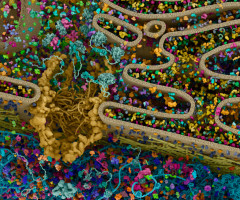
A team of Chinese scientists have recently reported a comprehensive proteomic analysis based on 103 Chinese patients with lung adenocarcinoma (LUAD), a leading cause of death among all types of cancer worldwide.
The research revealed LUAD-related molecular characteristics, their association with clinical outcomes, potential prognostic biomarkers and drug targets.
This study was published online in the journal Cell.
f Despite the remarkable progress in precision medicine by genomic study of LUAD in recent years, a large percentage of LUAD patients still lack targeted therapeutic strategies.
Since protein is the direct executor of biological activities, a comprehensive proteomic study of LUAD can fill the knowledge gap between genomic abnormality and oncogenic protein function.
To provide a comprehensive understanding of the molecular landscape of LUAD and offer the opportunity for more precise diagnosis and treatment of LUAD, scientists in this study performed integrated proteomic and phosphoproteomic analyses of tumour tissues and their paired noncancerous adjacent tissues from 103 LUAD patients.
A total of 11,119 proteins and 22,564 phosphorylation sites were identified.
Combining these proteomics data with clinical information and genomics data, a comprehensive molecular landscape of LUAD was obtained.
Scientists discovered that epithelial-mesenchymal transition, as well as inflammatory and oncogenic signalling pathways, likely led to poor prognosis in stage I LUAD.
They further established connections between genetic alterations and proteomic characteristics in patients with mutation of EGFR or TP53, two predominant driver genes in Chinese LUAD patients.
Elevated expression levels of two histological markers, TTF-1 and Napsin-A, and proteins in spliceosomes were observed in patients with EGFR mutation.
In patients with TP53 mutation, several oncogenic pathways, including DNA replication and mismatch repair, were changed noticeably.
Notably, the researchers classified all the patients into three proteomic subtypes (S-I, S-II, S-III), each containing distinct molecular features and clinical features.
Comprehensive bioinformatic analysis showed that S-I patients were associated with a cellular environment and good prognosis.
In contrast, S-III patients were associated with cell proliferation and proteome stability and a poor prognosis.
The phosphoproteomic analysis further revealed activated signalling pathways and kinases in different proteomic subtypes.
The integrative analysis of proteomics data and clinical data further revealed 27 potential plasma biomarkers and several drug targets for LUAD.
HSP 90β, one of the potential biomarkers, was further validated in an independent cohort.
This study provides new insights on LUAD beyond the current genomic understanding.
The proteomic dataset serves as a valuable and powerful resource for expediting the translation of basic research into more precise diagnosis and therapeutic treatments in clinical practice.
We are an independent charity and are not backed by a large company or society. We raise every penny ourselves to improve the standards of cancer care through education. You can help us continue our work to address inequalities in cancer care by making a donation.
Any donation, however small, contributes directly towards the costs of creating and sharing free oncology education.
Together we can get better outcomes for patients by tackling global inequalities in access to the results of cancer research.
Thank you for your support.